Zotac ZBOX MAGNUS EN980 SFF PC Review - An Innovative VR-Ready Gaming Powerhouse
by Ganesh T S on August 25, 2016 8:00 AM ESTPerformance Metrics - II
In this section, we mainly look at benchmark modes in programs used on a day-to-day basis, i.e, application performance and not synthetic workloads.
x264 Benchmark
First off, we have some video encoding benchmarks courtesy of x264 HD Benchmark v5.0. This is simply a test of CPU performance. As expected, the results are similar to that of the SYSmark section, for the same reasons.
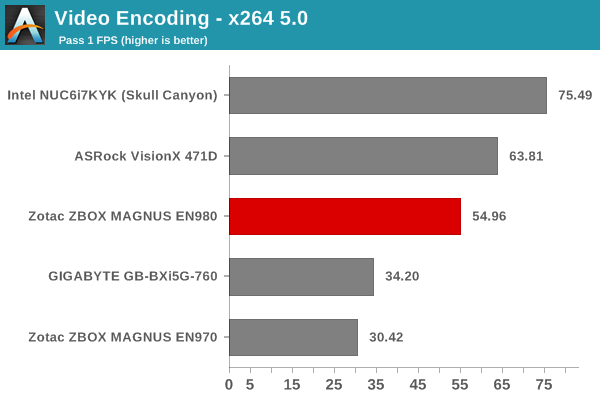
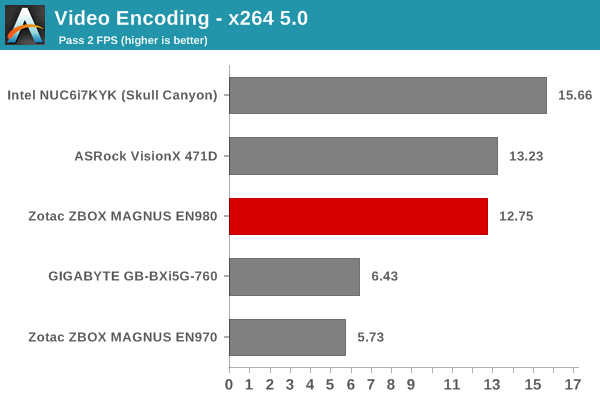
7-Zip
7-Zip is a very effective and efficient compression program, often beating out OpenCL accelerated commercial programs in benchmarks even while using just the CPU power. 7-Zip has a benchmarking program that provides tons of details regarding the underlying CPU's efficiency. In this subsection, we are interested in the compression and decompression MIPS ratings when utilizing all the available threads.
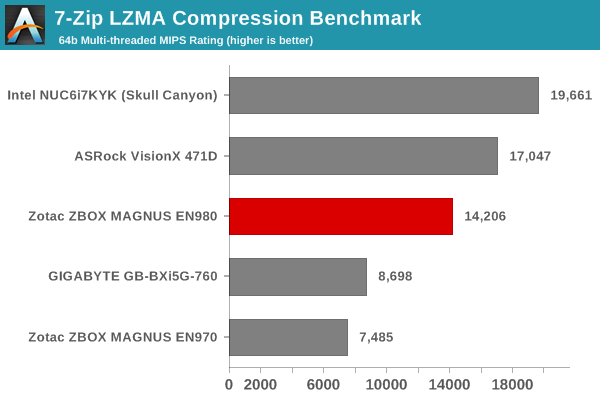
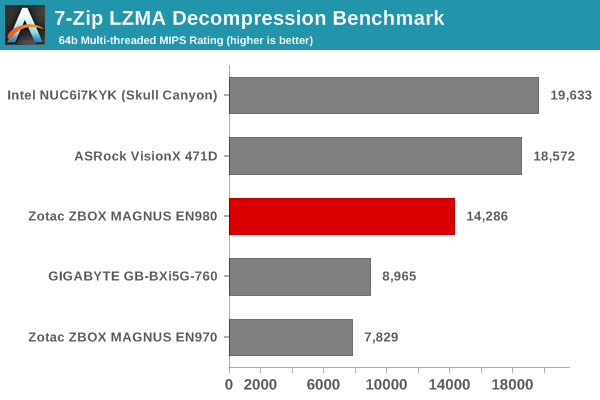
TrueCrypt
As businesses (and even home consumers) become more security conscious, the importance of encryption can't be overstated. CPUs supporting the AES-NI instruction can accelerate the encryption and decryption processes. The Core i5-6400 does have AES-NI support. TrueCrypt, a popular open-source disk encryption program can take advantage of the AES-NI capabilities. The TrueCrypt internal benchmark provides some interesting cryptography-related numbers. The AES speeds are graphed below. This is a purely CPU feature / clock speed based test.
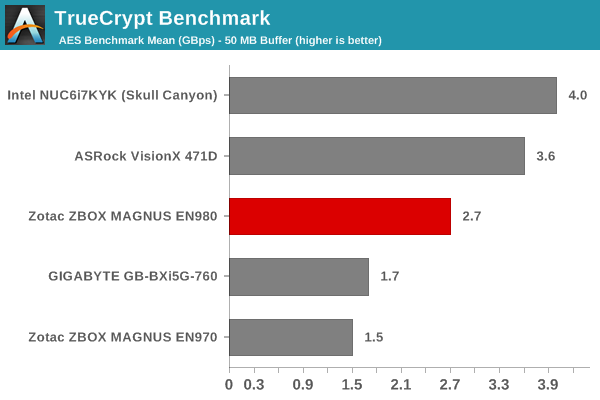
Agisoft Photoscan
Agisoft PhotoScan is a commercial program that converts 2D images into 3D point maps, meshes and textures. The program designers sent us a command line version in order to evaluate the efficiency of various systems that go under our review scanner. The command line version has two benchmark modes, one using the CPU and the other using both the CPU and GPU (via OpenCL). The benchmark takes around 50 photographs and does four stages of computation:
- Stage 1: Align Photographs
- Stage 2: Build Point Cloud (capable of OpenCL acceleration)
- Stage 3: Build Mesh
- Stage 4: Build Textures
We record the time taken for each stage. Since various elements of the software are single threaded, others multithreaded, and some use GPUs, it is interesting to record the effects of CPU generations, speeds, number of cores, DRAM parameters and the GPU using this software. OpenCL acceleration in Photoscan doesn't seem to have any dramatic effect in the GTX 980-equipped MAGNUS EN980.
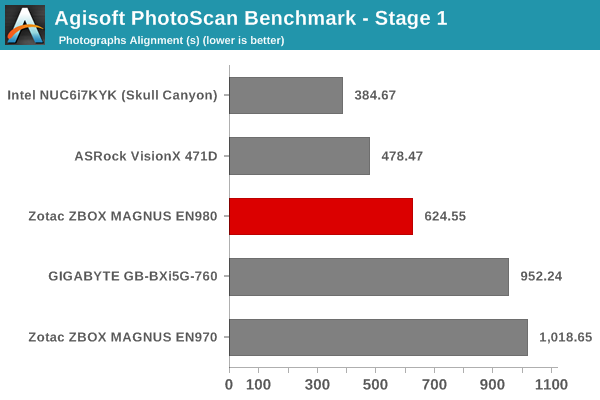
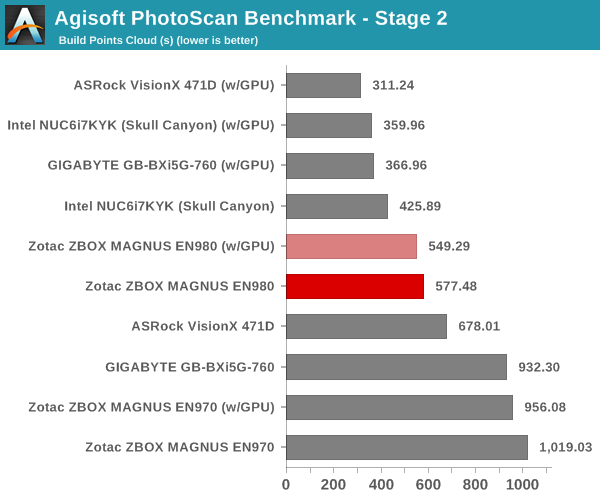
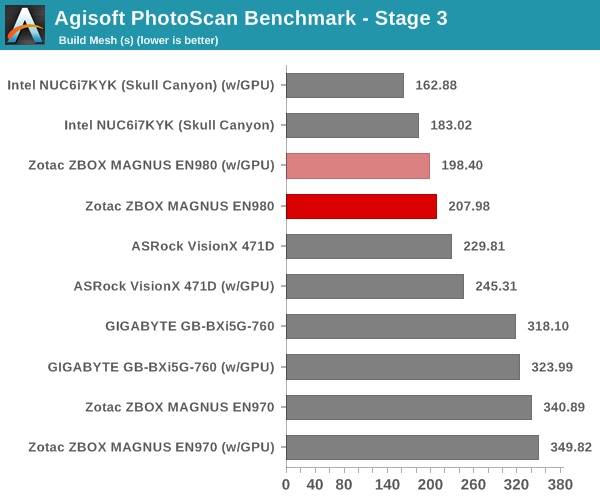
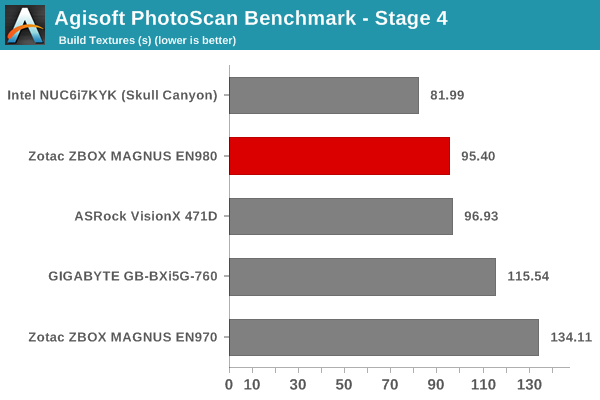
Dolphin Emulator
Wrapping up our application benchmark numbers is the Dolphin Emulator benchmark mode results. This is again a test of the CPU capabilities, and the ZBOX wins this one, thanks to its higher power budget compared to other systems.











30 Comments
View All Comments
nathanddrews - Thursday, August 25, 2016 - link
Revision 2.0 with Pascal and PCIe SSD should be interesting. The tiny design is really neat.Chaitanya - Thursday, August 25, 2016 - link
V2 with 1080 or 1070 has already been announced.nathanddrews - Thursday, August 25, 2016 - link
...ImSpartacus - Thursday, August 25, 2016 - link
That's going to be awesome. I hope they can cram some kaby lake in there as well as it'll surely have some minor improvements over Skylake.lament - Thursday, August 25, 2016 - link
Not v2 though.. different model EN10: http://techreport.com/news/30526/zotac-magnus-en10...Morawka - Thursday, August 25, 2016 - link
Tiny? this thing is huge. sure it's smaller than your typical M-ITX case but not far from it.Einy0 - Friday, August 26, 2016 - link
Is it just me or is a 250GB SSD is not enough for a gaming PC. I thought it would be enough a few years ago and quickly discovered that I was constantly shuffling games over to a HDD to make room. Most of the games from the past few years are about 40GB a piece. Looking at my current Steam folder, the Witcher 3 is 38GB and Shadow of Mordor is 42GB. With Windows 10 and a standard load of common apps and utilities, you are looking at 4 to 5 games installed. I suppose if you only use it for games it would okay.jamyryals - Thursday, August 25, 2016 - link
Looks like a terrific little box. The visual comparison to the Nuc was especially helpful to get size context. Too bad they couldn't get the Pascal cards in on this version.fallaha56 - Thursday, August 25, 2016 - link
too bad? deal breaker more like! no point being this far behind the curve...gtx1060 would wipe floor wit at every levelBrokenCrayons - Thursday, August 25, 2016 - link
It's an interesting system. As already mentioned in another comment, the NUC size comparison is useful for putting things in perspective about just how much more physical space it takes to gain gaming performance.I do question this line though:
"At this point of time, a premium gaming PC that can't be advertised as VR-ready can't get good market reception."
The monetary returns for companies producing VR hardware and VR-enabled software for consumer use isn't easy to find and we haven't had enough time or products out there to see any enduring trends about the latest round. All I've got is personal experience to work with here, but I see very little consumer demand because of the cost of entry and the unaddressed shortcomings that we saw with 90's era headgear being duplicated in current hardware.